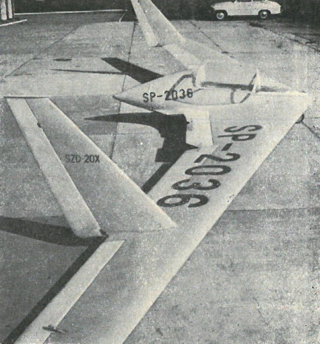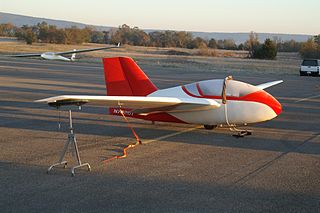
The Slingsby T.49 Capstan is a British two-seat glider of the 1960s built by Slingsby Sailplanes as a replacement for their earlier Type 42 Eagle. It is a high-winged monoplane of wooden construction, the last two-seat wooden glider built by Slingsby, intended for both training and general club flying. Side-by-side seats for the two pilots are accommodated in an enclosed cockpit with a one-piece perspex canopy. The prototype T.49A first flew in 1961, and it entered production as the T.49B in 1963. Thirty-four Capstans were built, one of which was fitted with an auxiliary engine with the designation T.49C Powered Capstan.

The SZD-6x Nietoperz was a single-seat tail-less experimental glider aircraft that was designed and built in Poland at Szybowcowy Zakład Doświadczalny in Bielsko-Biała in 1951. Only one example was constructed.
The SZD-25A Lis was a single-seat glider aircraft that was designed and built in Poland from 1955, derived from the SZD-16 Gil and SZD-25 Nov.

The SZD-17X Jaskółka L was a single-seat high-performance competition glider designed and built in Poland at Szybowcowy Zakład Doświadczalny in Bielsko-Biała in 1955.

The SZD-18 Czajka was a single-seat glider designed and built in Poland in 1956.

The SZD-20x Wampir II was a single-seat tail-less research glider designed and built in Poland from 1959.

The SZD-24 Foka (Seal) was a single-seat high-performance aerobatic glider designed and built in Poland in 1960.
The SZD-35 Bekas (Snipe) is a two-seater glider aircraft that was designed and built in Poland.

The IS-4 Jastrząb was a single-seat aerobatic glider designed and built in Poland from 1949.
The Neiva BN-1 was a high performance single seat sailplane designed in Brazil in the 1950s. It had national records, competition success, and went into production for club use.

The Marske Pioneer is a family of American, single-seat, mid-wing, tailless gliders that was designed by Jim Marske. The Pioneer II version was available as plans and in kit form from Marske Aircraft Corporation for amateur construction.

The Antonov A-15 is a Soviet mid-wing, V-tailed single-seat, FAI Open Class glider that was designed by Oleg Antonov and produced by Antonov.
The Danieli Piuma is a family of Italian high-wing, strut-braced, pusher configuration single-seat motor gliders that was designed by Tiziano Danieli of Schio and supplied as plans for amateur construction.
The Ciani EC.37/53 Spillo or SSVV EC.37/53 Spillo was a single seat competition glider designed and built in Italy in the 1950s. It had the highest aspect ratio wing of any wooden glider. Only one was built.
The CVT1 Zigilo was a single-seat, 12-metre-span (39 ft) Italian training glider designed and built in Italy in the 1950s. Only one was completed.
The IIL IS-10 was a high-performance, single-seat glider, designed and built in Romania in the early 1960s. It was the first Romanian aircraft to use laminar flow airfoils.

The ICA IAR-35 is a Romanian glider designed and built in the 1980s primarily for aerobatics, though capable of general purpose use. Several production prototypes were constructed.
The Schleicher K 10 is a Standard class competition glider, designed by Rudolf Kaiser and built in Germany in 1963. Only a few were produced.

The TeST TST-5 Variant is a Czech homebuilt aircraft that was designed and produced by TeST Gliders of Brno, introduced c. 1998. When it was available the aircraft was supplied as a completely assembled aircraft, without engine or instruments, and also as a kit for amateur construction.
The Politechnika Warszawska PW-3 Bakcyl (Microbe) is a Polish primary glider developed from the PW-2 Gapa.











